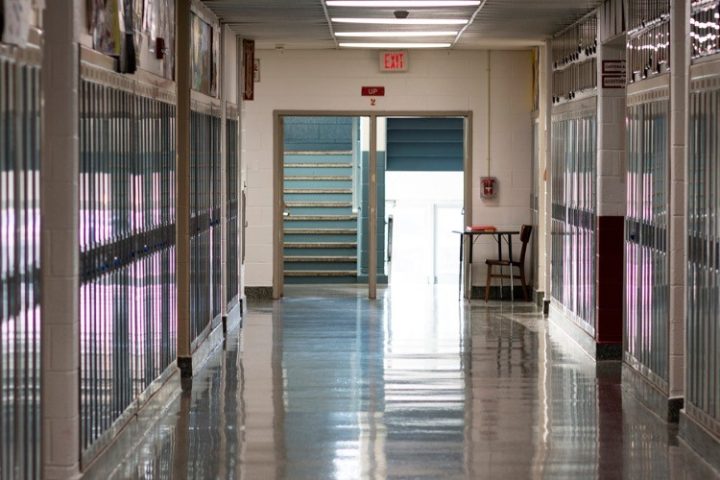
The San Diego Unified School District is arranging for migrant children to get in-person teaching as local kids remain stuck in virtual classes.
On March 29, San Diego County Office of Education (SDCOE) confirmed that it is “providing the educational program for the unaccompanied migrant children” staying at the San Diego Convention Center. The center is being used as a temporary holding facility for the record number of unaccompanied minors that are flocking to the United States. The convention center will house a maximum of 1,450 teenage girls, ages 13 to 17, the Los Angeles Times reported, and is scheduled to remain a shelter until July 15 as part of the Biden administration’s strategy for dealing with the border crisis.
Seventy-five percent of San Diego students are currently learning in an online-only format and are expected to move into a hybrid model on April 12, where they will be learning in a combination of in-person and online formats, according to the school district’s website.
The same teachers who now eagerly arrange in-person education for immigrant children fiercely fought against school reopening for the local kids just a couple of weeks ago.
Teachers’ unions insisted it was still “too dangerous” for children, teachers, and staff to hold in-person classes and pushed back on the reopening date. They made certain demands, according to an e-mail obtained by local news site Voice of San Diego.
First of all, teachers refused to abandon virtual learning until vaccines are made available for every staff member despite the CDC repeatedly insisting that it is safe for teachers to return to the classroom without vaccines.
Teachers’ unions also insist on costly virus-mitigation measures to be in place before returning to in-person instruction, despite the fact that the San Diego Unified School District alone received $240 million from the CARES Act and another $342.6 million from the American Rescue Plan, and received significant flows of cash for “COVID-related expenses.” Add to that a $32,071,000 school budget. According to the most recent compilation from Ed Week for 2019, California’s average budget is $12,143 per pupil. Add another $1,000 to adjust to “COVID-related” expenses and hire first-grade teachers, and you can still bathe in leftover cash.
Another demand the unions are making is for San Diego County to be placed in the state’s “red tier” for COVID infection, meaning the COVID infection rate should be seven per 100,000 residents (.007 percent) or less before schools reopen. The rolling percentage positive (over a 14-day time period) is reported at three percent among San Diegans. At the same time, of more than 700 unaccompanied children currently transferred to the convention center, at least 82, or around 11 percent, have tested positive for the virus, as confirmed by the U.S. Department of Health and Human Services.
Teachers are offering in-person instruction to illegal immigrant children out of compassion, we are told. “Our teachers have volunteered to help — we are not paying them in any way — because caring for children is central to who they are as human beings. The power of their example should inspire us all, and hopefully many others will be inspired to show these girls that we are a compassionate community,” said San Diego Unified School District spokeswoman Maureen Magee, who noted that “all children in California, regardless of immigration status, have a constitutional right to education. We also have a moral obligation to ensure a bright future for our children.” Magee did not specify why San Diegan children are excluded from teachers’ compassion.
White House Press Secretary Jen Psaki backed the SDCOE’s decision: “As I understand it, San Diego public schools are opening in early April. Students will be back in the classroom — part time — and certainly you know our objective from the White House — 5 days a week for the majority of schools across the country…. I believe they’re also on spring break right now. I am not sure if it’s volunteer, or paid, you’d have to ask a local school district.” Still, it’s unclear why local children will return to a hybrid model in which they attend school two days a week for in-person learning and have three days a week of virtual learning — in which they spend only 0.5 hours online and spend the rest of the day doing “asynchronous” work by themselves without teacher supervision — while the migrant children enjoy an in-person education every day.
In addition to providing in-person instruction for the migrant minors, the local hospitality extends to providing the kids three meals a day, flip phones to call their families, and one-on-one pro bono legal aid, as reported by Town Hall.
This all sounds very generous, but the Golden State is far from taking good care of its own children. In California, there are 1,362,340 children struggling with hunger (that is one in seven). Almost 270,000 students in K-12 schools lacked stable housing in 2018-19, numbers that almost certainly have grown since the pandemic and economic downturn began last spring, researchers said. Why don’t teachers offer their compassion to these kids? Both local and federal governments try to address the issue by spending more, but this is still inadequate, as the root cause remains: High taxes and rapidly worsening infrastructure, paired with severe COVID lockdowns, are chasing businesses and residents away, while social problems such as homelessness and hunger continue to rise, along with calls for more spending, more taxes, more subsidies, and more aid.




